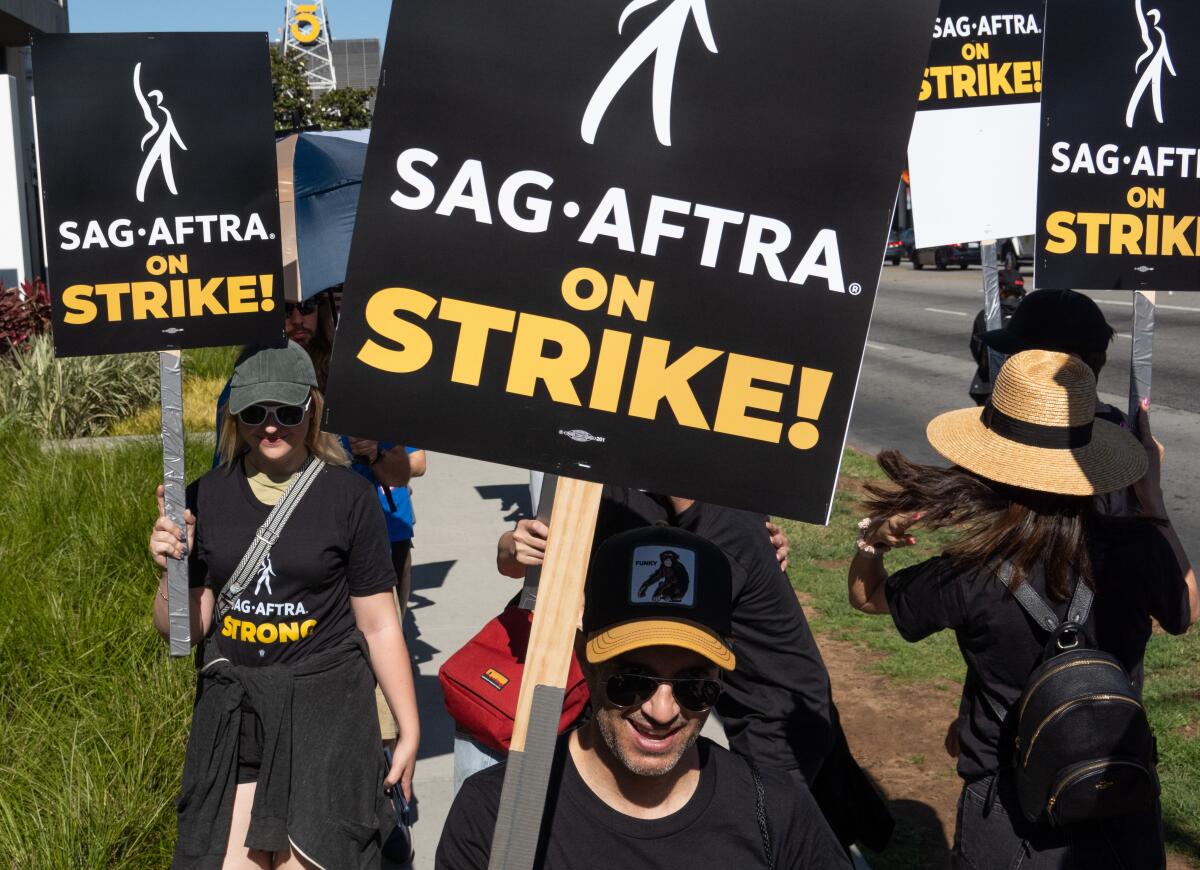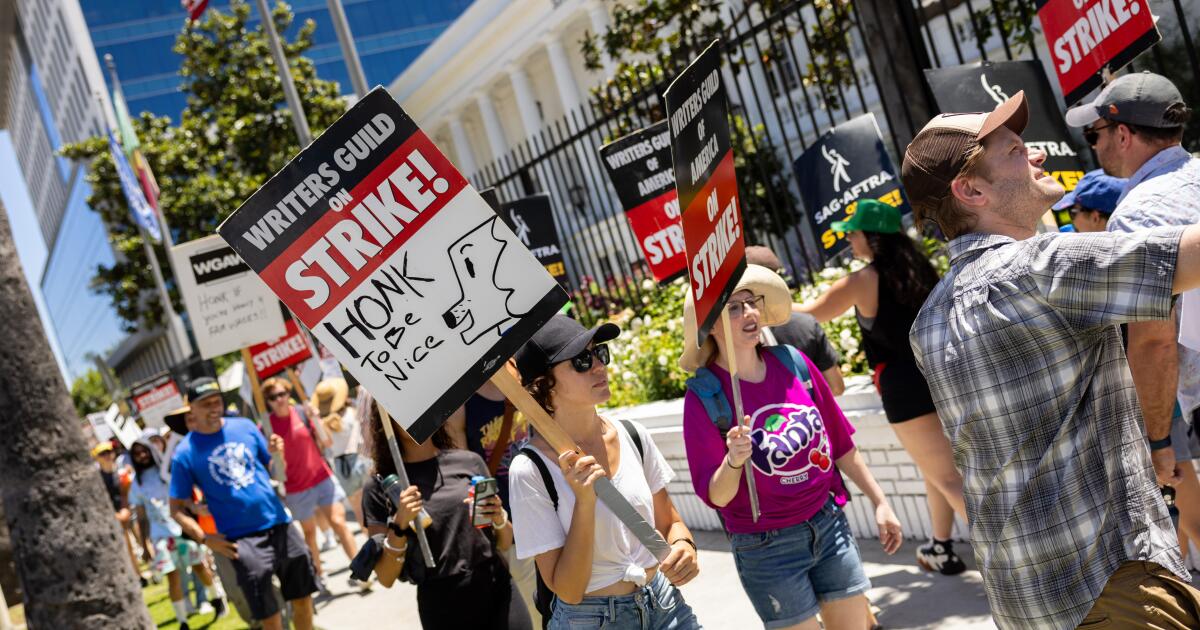Hollywood had hoped its summer of strikes would end by Labor Day, but ongoing talks between the unions and the studios have failed to produce a meaningful breakthrough.
Three weeks ago, the companies gave the Writers Guild of America a proposal that included increased compensation, among other offers, but the union dismissed the effort as “half measures,” not enough to narrow the gap that prompted 11,500 writers to go on strike four months ago.
WGA members were joined in mid-July by the 160,000-member performers’ union, SAG-AFTRA, after the collapse of its contract talks with the studios, including Walt Disney Co., Netflix, Amazon Studios and Warner Bros. Discovery.
“It increasingly looks like Hollywood will not be back in business until the beginning of 2024, at the earliest,” research firm LightShed Partners said this week in a note to clients, noting that scenario was “an unthinkable outcome when the WGA went on strike in May.”
How did the entertainment industry become stuck in labor quicksand?
Frustration, fears about the future and a high degree of mistrust continue to shape the script.
Writers quickly trumped the companies in the ongoing PR battle by using social media to amplify their cause. Typically sure-footed media titans found themselves on unfamiliar ground — portrayed as out-of-touch corporate fat cats. After several messaging missteps, the companies and their negotiating arm, the Alliance of Motion Picture and Television Producers, last week hired a crisis communications firm.
“I don’t know if it’s the billions of dollars that surround their jobs or dealing with Wall Street that has insulated them, but they can’t even pretend to say the right things, which they normally do,” said Matthew Weiner, creator of the hit AMC drama “Mad Men,” earlier this week while picketing outside of Netflix’s Hollywood campus.
An AMPTP representative declined to comment for this story. The WGA declined to comment on the state of negotiations.
As the twin strikes stretch into September, pressure is building on both sides to find common ground.
Producers are eager to restart production. Executives worry that six more weeks of strikes could obliterate the entire television season and jeopardize next summer’s movie releases. They don’t want the strike to do lasting damage to their businesses. There is a sense that the companies must resolve the strikes by October, according to several knowledgeable insiders.
Meanwhile, corporate leaders also are facing pressure from vocal politicians to resolve the conflicts.
California Treasurer Fiona Ma this week sent harshly worded letters to company leaders, including Disney Chief Executive Bob Iger and Brian Roberts, chairman of Comcast Corp., which owns NBCUniversal. “Your failure to come to an agreement is threatening the industry’s ability to ensure that writing, acting and other positions are viewed as sustainable careers in California,” the Democrat wrote.
Los Angeles Mayor Karen Bass has offered to help facilitate the dialogue: “I am more than willing to convene people if and when it is appropriate and both sides have told me that if they felt there was a need that they would absolutely respond.”
“We appreciate the support writers have received from our elected allies,” WGA said in a statement. “The studios are the only ones who can end the strike — by negotiating a fair deal.”
Talent agents have agitated for the strikes to end. Some writers have received calls from agents encouraging them to take the deal offered by the AMPTP, according to David Simon, who is on the WGA’s negotiating committee.
“Greatly resent not being among the TV showrunners who took a weekend call from an agent urging our union to accept a first-offer-in-four-months, one-hand-giveth-while-the-other-taketh-back deal,” Simon, creator of HBO’s acclaimed “The Wire,” wrote Tuesday on X. “Missed opportunity to call some [agent] wonder a greedy, empty shill.”
Simon did not respond to The Times’ request for comment.
Unlike the previous writers’ strike 15 years ago, the WGA thus far has benefited from cohesion within its ranks, reinforced by aggressive use of social media to amplify its message and discourage dissent.
The union also has been buoyed by a nationwide rise in union activism.
Los Angeles has become a hot spot for labor this summer with workers in healthcare and hospitality striking, driven primarily by anger over increasing pay disparities, the high cost of living and a shrinking middle class.
Earlier this week, more than 200 union nurses marched alongside WGA and SAG-AFTRA members in 85-degree heat outside Netflix in Hollywood.
“It feels like the rest of the country and the rest of the world is behind us,” said Marc Guggenheim, showrunner for “DC’s Legends of Tomorrow.”
Resentment toward media chiefs who are awarded annual compensation packages that typically top $20 million has contributed to workers’ frustrations, industry insiders concede. Some workers struggle to make a decent living in high-priced Los Angeles.
But the dispute goes beyond wages.
Some writers say they’re concerned the screenwriting profession could become just another branch of technology’s gig economy.
“What we are fighting this time isn’t just about percentages and numbers, how much they’re gonna put in the health plan, pension plan,” said Rasheed Newson, executive producer and co-developer of “Bel-Air,” at a recent event in San Francisco promoting his debut novel, “My Government Means to Kill Me.” “We are talking about whether or not there is going to be a Writers Guild in 10, 20 years.”
But Hollywood’s supporting cast, including many caught in a financial crunch, are becoming desperate for a resolution that would spur the industry back to work.
Entertainment-related businesses, including talent agencies, have laid off workers, and prop houses are being financially squeezed.
Todd Holmes, associate professor of entertainment media management at Cal State Northridge, estimated that the economic damage of the dual strikes on California was at least $3.5 billion so far and that it could balloon to $4 billion to $5 billion if the strikes were to stretch into October.
“They’ve got to get something accomplished,” actor Robert Hawkey, a SAG-AFTRA strike captain, said of the negotiators, summing up the mood of many on a boisterous picket line on Sunset Boulevard this week.
“There needs to be give-and-take on both sides or else it’s really going to hurt a lot of people,” Hawkey said. “They’re going to lose their homes; they won’t be able to pay their bills.”

SAG-AFTRA members picket outside Netflix and Sunset Bronson Studios in Los Angeles.
(Myung J. Chun / Los Angeles Times)
The stage had long been set for a clash.
In early 2020, as the WGA approached its last round of negotiations, guild leaders were gearing up to press their issues related to streaming. But the WGA recognized that media companies were already reeling from the fallout of COVID-19 shutdowns.
“The guilds missed their shot three years ago to get a recalibration of the issues when streaming was on the ascension,” said media attorney Robert Schwartz of Quinn Emanuel. “Now, the business that once looked like a cash cow is seriously ill. The actors and the writers, in a lot of ways, feel like they have been screwed — and in some ways they have.”
Since last year, investors have taken a dim view of the billion-dollar losses absorbed by companies like Disney, Warner Bros. Discovery and Paramount Global in their efforts to build streaming services to compete with Netflix. During a July interview with CNBC from Sun Valley, Idaho, Iger suggested that writers should be more mindful of the troubled economic landscape.
“There’s a level of expectation that they have, that is just not realistic,” Iger said, becoming a target of writers’ ire.
Duncan Crabtree-Ireland, chief negotiator for SAG-AFTRA, said in an interview that he wasn’t sure how long the strikes would last, noting the AMPTP hasn’t engaged with the actors’ group since July 12.
“It’s a question of how long does it take for the companies to realize that our members aren’t going to back down on central issues about their future, whether that’s basic economic fairness or whether that’s AI,” Crabtree-Ireland said.
In the WGA negotiations, the AMPTP released its Aug. 11 proposal, which the alliance said “addresses all of the issues the Guild has identified as its highest priorities.”
“We are deeply committed to ending the strike and are hopeful that the WGA will work toward the same resolution,” said Carol Lombardini in a statement released last week.
The studios said they offered the WGA the largest pay bump in 35 years, with minimum wages increasing 5% in the first year of the contract, followed by gains of 4% and 3.5% in subsequent years. The WGA had sought a 6% increase to minimums and residual bases in the first year, followed by 5% increases in the second and third years.
One of the biggest sticking points has been WGA’s demand for a minimum number of writers on a show.
Historically, studios employed writers’ rooms, which were staffed with more than a dozen scribes, to quickly churn out enough TV episodes to fill a network season. Larger rooms have helped to encourage diversity in storytelling, writers said.
But the size of writers’ rooms has shrunk because the streamers order fewer episodes of a series.
In the negotiations, companies have refused to let the union set staffing levels. That’s a management role, executives say, adding that not all showrunners want additional writers.
“It’s all about saving money,” Weiner said, adding that “Mad Men” averaged 10 writers.
“I could never have done that show by myself,” he said. “I definitely couldn’t have written that many scripts or come up with that much story. There’s not a show in history that you liked that didn’t have a writers’ room … ‘Star Trek’ … ‘[I Love] Lucy’… ‘The Twilight Zone.’”
The WGA also has expressed its concern that, under the streaming model, writers are no longer employed throughout the production of the show, and therefore they lose valuable storytelling experience.
“I have always been in writers’ rooms and benefited from the multiple points of view,” veteran showrunner Becky Hartman Edwards said. “Coming up through the ’90s, the 2000s, I got sent to the set, where I made horrible mistakes at first — but that’s how I learned.”
Younger writers are missing out because they are not going on set, “and they are the creators of the future,” Hartman Edwards said.
Studio executives say they share such worries and they also have an incentive to nurture the next generation of storytellers.
AMPTP has offered that showrunners could decide their own staffing needs. On a high-budget streaming and pay-TV series, the AMPTP proposed a guarantee that writers would have a minimum of 10 weeks of employment in development rooms.
But the WGA’s negotiating committee said the “loopholes, limitations and omissions” made the offer “toothless.”
Staff writer Rong-Gong Lin II contributed to this report.




